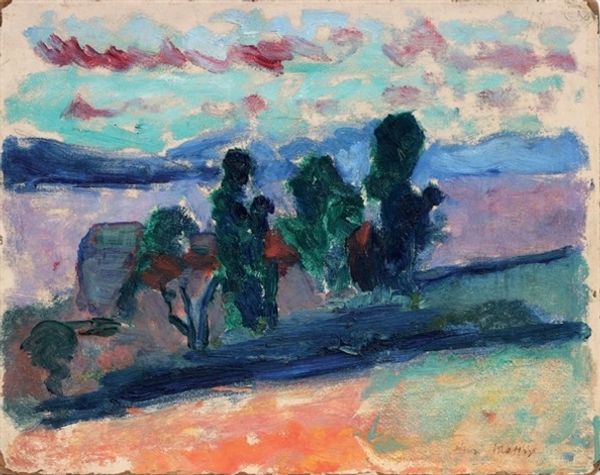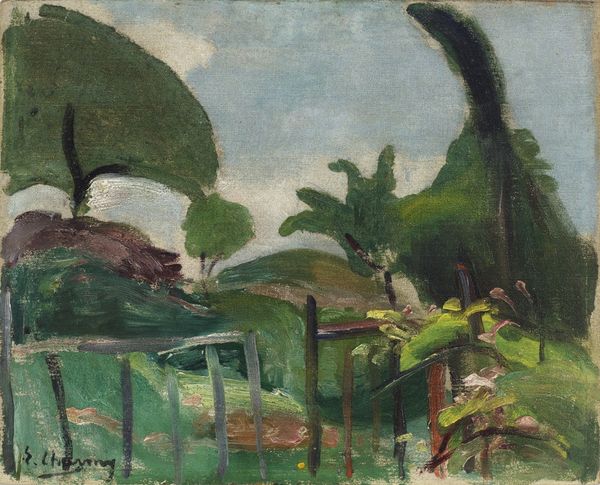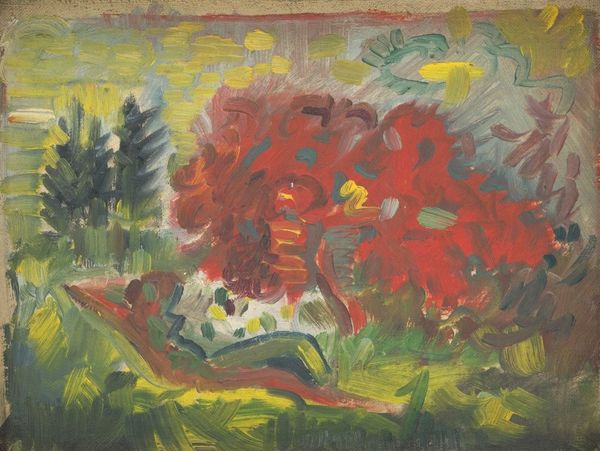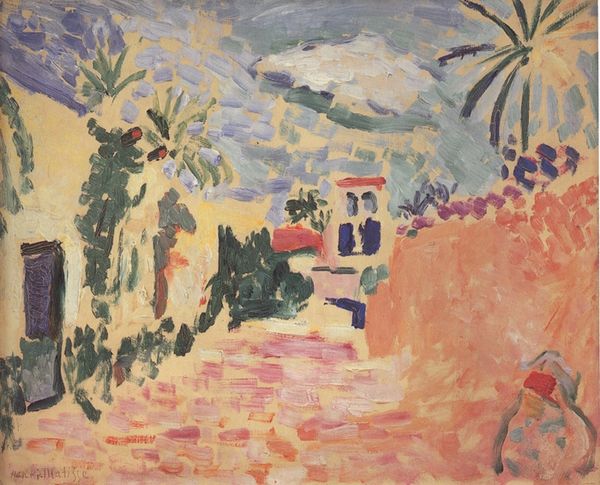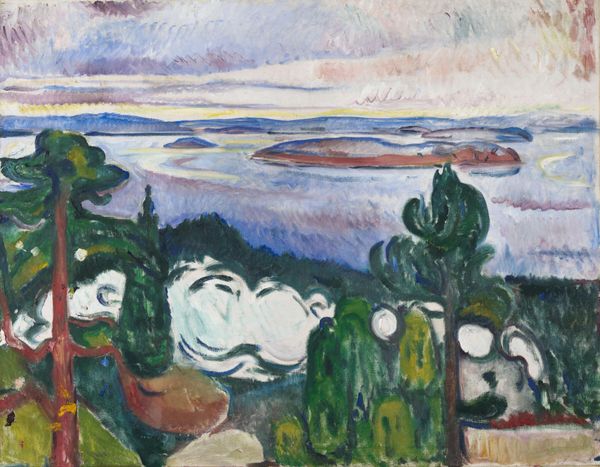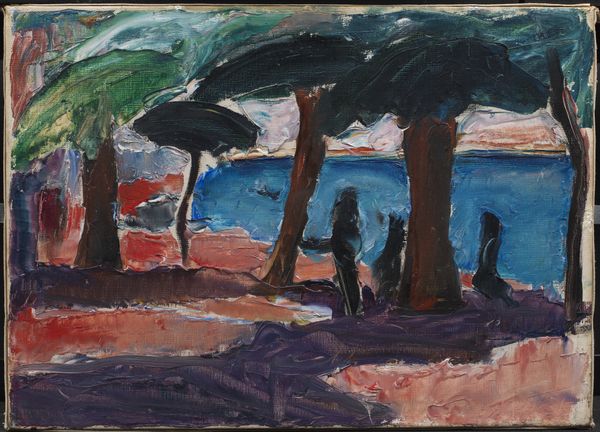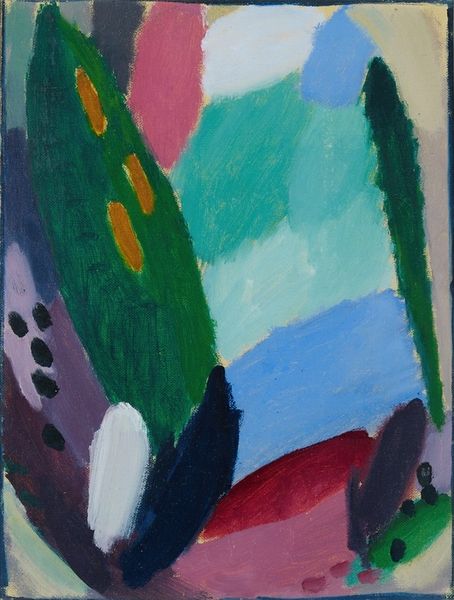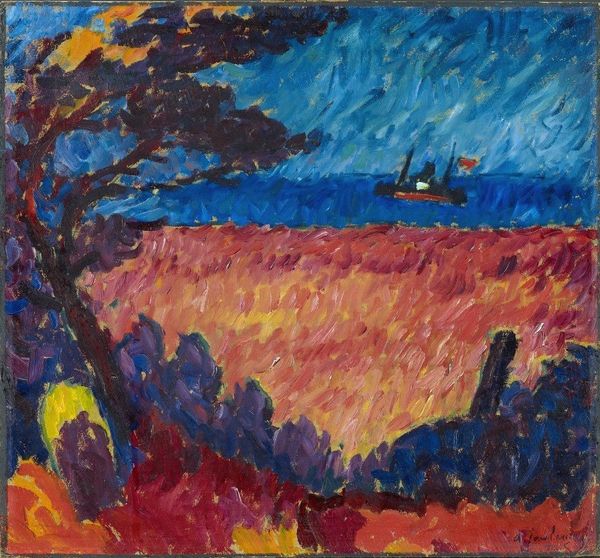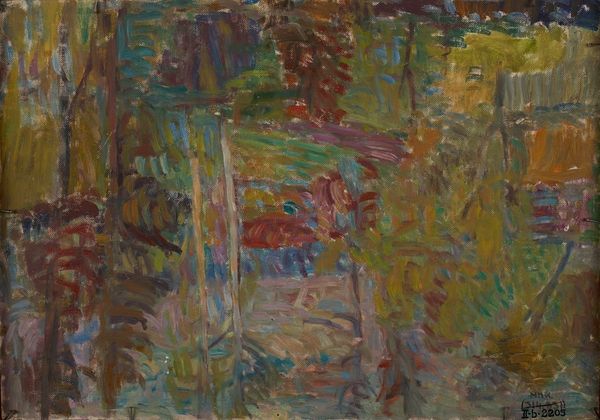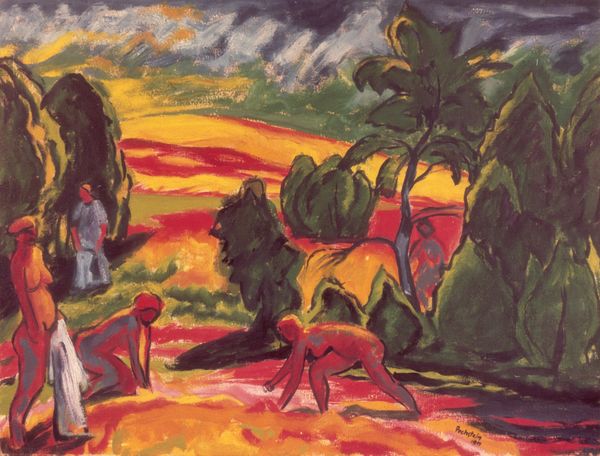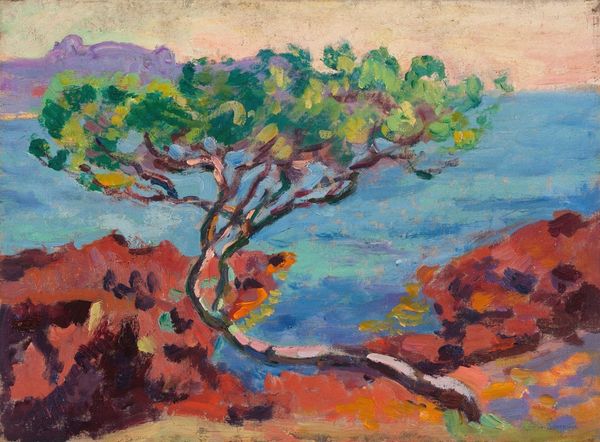
Dimensions: support: 460 x 550 mm frame: 600 x 705 x 60mm
Copyright: By permission of the estate of the artist | CC-BY-NC-ND 4.0 DEED, Photo: Tate
Curator: Here we have Sir Matthew Smith’s "Landscape near Antibes," a piece that invites us to consider the idyllic and the embodied experience of landscape. Editor: It immediately strikes me as a scene drenched in vibrant, almost Fauvist color—especially the pink sky contrasting with the deep greens. Curator: Smith, who lived from 1879 to 1959, often explored themes of sensuality and pleasure through his art. Given that it is the French Riviera, how do you think the landscape informs this? Editor: The thick application of paint and the simplified forms suggest a certain immediacy, a capturing of a fleeting moment. It speaks to a desire for escapism, but also a connection to the earth. Curator: Absolutely. And during this period, landscape paintings were rarely just about the scenery; they often reflected social attitudes towards nature and leisure. Editor: It's a captivating interplay of color and form, urging us to look beyond the surface. Curator: Indeed, a landscape not just seen, but felt, in its historical and social context.
Comments
tate 6 months ago
⋮
http://www.tate.org.uk/art/artworks/smith-landscape-near-antibes-t06493
Join the conversation
Join millions of artists and users on Artera today and experience the ultimate creative platform.
tate 6 months ago
⋮
The novelist Henry Green (1905-73) described Matthew Smith's landscapes of the South of France as 'lyrical poems' evoking 'that moment of fleeting dusk which lasts down there for perhaps thirty short minutes' ('Matthew Smith - A Personal Tribute' in Tate Gallery 1953, pp.9-10). Landscape near Antibes, with its salmon pink and aqua sky, is a typical example of the landscapes Smith painted in the mid 1930s when he lived at Cagnes-sur-Mer and then Aix-en-Provence. At Cagnes he settled for almost two years at the Hôtel Le Cagnard, set on a hill above the town with views overlooking Cap d'Antibes. Landscape near Antibes may have been painted during this stay. Finding himself without suitable studio space, Smith would take his car out into the countryside, painting en plein air with characteristic fluency. He quickly applied thick opaque oils to his canvases, often rapidly brushing wet-into-wet and throwing the finished works into the back of his car with the paint not yet dry. Landscape near Antibes, with its directness and immediacy, has the character of just such a painting. Born in Halifax in Yorkshire in 1879, Smith spent much of his working life in France, always feeling his work to be closer to French than British aesthetics. It was not until September 1908, however, when he was nearly thirty, that Smith first ventured to France. He later recalled how 'my instincts drew me, as they have drawn hundreds and thousands of painters, to [its] rich soil' (quoted in Mary Sorrell, 'Matthew Smith', Apollo, vol.48, August 1948, p.30). Retracing the footsteps of artists such as Jean-Baptiste-Camille Corot (1796-1875), Eugène Boudin (1824-98) and most recently Paul Gauguin (1848-1903), he arrived in Pont Aven, Brittany. Immediately taken with the place, he described how 'here my life began; my mind began to open out' (quoted in John Rothenstein, Modern English Painters, London 1952, I, p.193). From Pont Aven he travelled to Etaples in Pas-de-Calais and then on to Paris in 1910-12, attending the short-lived school run by Henri Matisse (1869-1954) early in 1911. After his marriage in 1912 to the artist Gwendolen Salmond (1877-1958) he returned to France, living there intermittently until June 1940. In his years in the South of France, Smith threw himself energetically into landscape painting, just as he had immersed himself a decade earlier in prolific studies of the nude. These landscapes recall the work of André Derain (1880-1954) and André Dunoyer de Segonzac (1884-1974), whose canvases conjured a world of rural idyll and national renewal in the uncertain inter-war years. Smith's landscapes are similarly romanticised, eliminating such signs of modernity as cars, railways and telegraph poles. Decidedly less harsh and distressed than his earlier Cornish landscapes, such as the violently coloured, black-skied Cornish Church of 1920 (Tate N05903), these scenes were generally clement and placid. According to Sir Philip Hendy (1900-80), Director of the National Gallery, they possessed 'a rhythm that pulls us into them and into the worship of nature, of which Matthew Smith was a high priest' ('Foreword' in Sir Philip Hendy, Francis Halliday and John Russell, Matthew Smith, London 1962, unpaginated). While Smith felt a deep sensibility for France's landscapes and artistic traditions, his work found favour predominantly with British audiences and sold largely through galleries in London. Landscape near Antibes was exhibited in Smith's solo show at Arthur Tooth and Sons in April 1934, and was later sent as a gift to Dr V. Smallpeice, in gratitude for her treating Smith at the Acland Hospital in Oxford during the Second World War. Further Reading:Matthew Smith, exhibition catalogue, Barbican Art Gallery, London 1983Matthew Smith: Paintings from 1909 to 1952, exhibition catalogue, Tate Gallery, London 1953Malcolm Yorke, Matthew Smith: His Life and Reputation, London 1997, pp.150-8 Jacky KleinJune 2002

